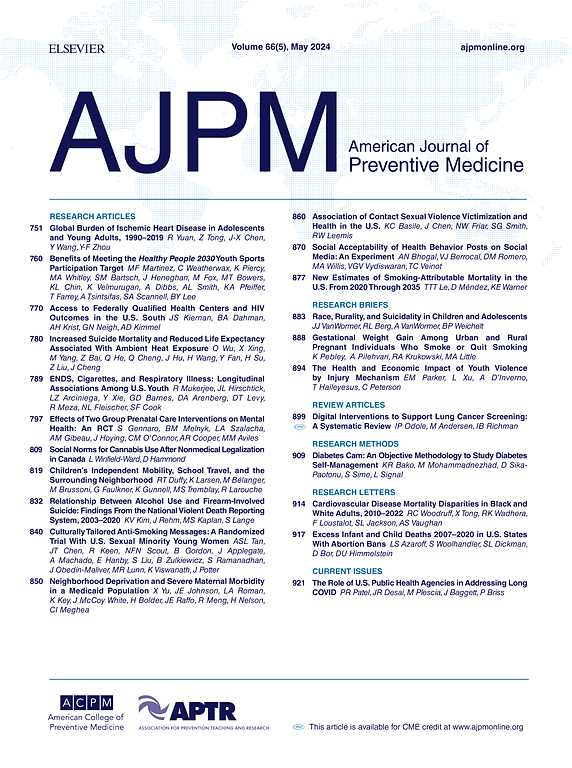整合预防医学和运动康复:运动人群慢性踝关节不稳定管理最佳策略的网络荟萃分析
IF 4.5
2区 医学
Q1 MEDICINE, GENERAL & INTERNAL
引用次数: 0
摘要
目的慢性踝关节不稳定(CAI)是一个重大的公共卫生挑战,增加了复发性损伤和长期肌肉骨骼变性的风险。本研究从预防医学角度评估CAI患者的康复干预措施,旨在确定康复和预防复发性不稳定的最佳策略,并减少与CAI相关残疾相关的医疗负担。方法本研究系统分析了包括Web of Science在内的多个数据库中符合条件的随机对照试验,重点关注有可能预防CAI复发的干预措施。采用Cochrane偏倚风险工具评估纳入研究的方法学质量。采用STATA 15.1软件进行网络meta分析。结果包括Graston器械辅助软组织活动结合动态平衡训练和综合力量平衡训练在内的干预措施均能显著改善CAI患者的SEBT评分。不稳定装置和平衡板训练在提高足踝能力测量(FAAM)得分方面效果良好,通过恢复功能能力直接支持预防性康复。结论在研究的15项干预措施中,Graston器械辅助软组织活动结合动态平衡训练是提高CAI患者SEBT评分的最佳干预措施,为卫生保健系统制定相应的预防方案提供了理论依据。然而,由于原始研究的局限性和潜在的偏倚,这些结论的强度应谨慎解释。需要进一步的高质量随机对照试验来证实这些发现,并为CAI的康复和预防提出循证建议。本文章由计算机程序翻译,如有差异,请以英文原文为准。
Integrating Preventive Medicine and Sports Rehabilitation: A Network Meta-analysis of Optimal Strategies for Chronic Ankle Instability Management in Active Populations
Objective
Chronic ankle instability (CAI) poses a major public health challenge, increasing the risk of recurrent injury and long-term musculoskeletal degeneration. This study evaluates rehabilitation interventions for CAI patients from a preventive medicine perspective, aiming to identify the best strategies for rehabilitation and prevention of recurrent instability and reduce the healthcare burden associated with CAI-related disability.
Methods
This study systematically analyzed eligible randomized controlled trials from multiple databases including Web of Science, focusing on interventions with the potential to prevent CAI recurrence. The methodological quality of the included studies was assessed using the Cochrane Risk of Bias Tool. Network meta-analysis was performed using STATA 15.1 software.
Results
Several interventions, including Graston instrument-assisted soft tissue mobilization combined with dynamic balance training and comprehensive strength and balance training, showed significant improvements in SEBT scores in patients with CAI. Instability devices and balance board training showed good results in improving Foot and Ankle Ability Measure (FAAM) scores, directly supporting preventive rehabilitation by restoring functional ability.
Conclusion
Among the 15 interventions studied, Graston instrument-assisted soft tissue mobilization combined with dynamic balance training was identified as the best intervention to improve SEBT scores in patients with CAI, providing a theoretical basis for healthcare systems to develop appropriate prevention programs. However, the strength of these conclusions should be interpreted with caution due to limitations and potential biases of the primary studies. Further high-quality randomized controlled trials are needed to confirm these findings and develop evidence-based recommendations for the rehabilitation and prevention of CAI.
求助全文
通过发布文献求助,成功后即可免费获取论文全文。
去求助
来源期刊

American Journal of Preventive Medicine
医学-公共卫生、环境卫生与职业卫生
CiteScore
8.60
自引率
1.80%
发文量
395
审稿时长
32 days
期刊介绍:
The American Journal of Preventive Medicine is the official journal of the American College of Preventive Medicine and the Association for Prevention Teaching and Research. It publishes articles in the areas of prevention research, teaching, practice and policy. Original research is published on interventions aimed at the prevention of chronic and acute disease and the promotion of individual and community health.
Of particular emphasis are papers that address the primary and secondary prevention of important clinical, behavioral and public health issues such as injury and violence, infectious disease, women''s health, smoking, sedentary behaviors and physical activity, nutrition, diabetes, obesity, and substance use disorders. Papers also address educational initiatives aimed at improving the ability of health professionals to provide effective clinical prevention and public health services. Papers on health services research pertinent to prevention and public health are also published. The journal also publishes official policy statements from the two co-sponsoring organizations, review articles, media reviews, and editorials. Finally, the journal periodically publishes supplements and special theme issues devoted to areas of current interest to the prevention community.
 求助内容:
求助内容: 应助结果提醒方式:
应助结果提醒方式:


